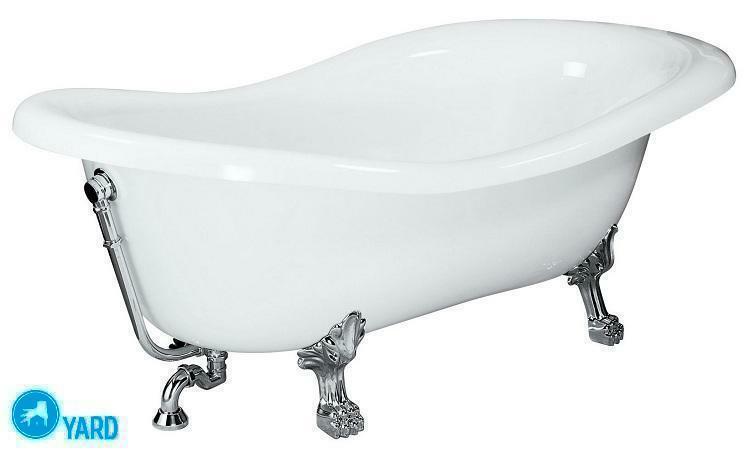
- Restoring cast-iron bath
- Restoration methods
- Liquid acrylic
- New enamel layer
- Acrylic liner
A couple of decades after the purchase of the bath, it may form chips and cracks of a different nature. In addition, the primordial bath enamel can have an unpleasant yellowish hue. All these signs indicate that the bath enamel has already served its time, and that it has acquired a new, eye-pleasing look, it needs to be restored. About what is any technology of restoration of baths, you will learn from this article.
to the table of contents ↑Restoring the cast-iron bath
A good bath in our time is not cheap - for this reason many masters come to the decision of enamel restoration for the sake of economy. This is due to the following reasons:
- Saving money. As mentioned, the new plumbing is not cheap, in addition, in this case you have to spend money on the removal of the old bathroom, transportation of plumbing and installation of a new one.
- Speed of the work. The master restores the bath for about 4 hours, after which it can be used actively after two days.
- Quality work. The new enamel will last you from 10 to 20 years - it all depends on how carefully you treat the plumbing.
- Wide range of colors. Usually the bath is painted in white, however, at the request of the customer, it can be painted in any color, adding to the composition of the color paste.
- The ability of long-term heat preservation.
Methods of restoration
There are three types of restoration of bathtubs, each of which is in its own way effective:
- Acrylic coating. With its help, apply liquid acrylic solution to the surface of the bowl by filling. In this case, all irregularities will disappear, the bath will not have an unpleasant smell, and it will last about 10 years.
- New enamel layer. This method is the application of a special enamel on the surface of a bowl of a bathroom, it is similar to the usual painting. The advantages of such coverage include low cost.
- Acrylic liner. On the old surface of the bowl is placed an insert of acrylic, completely repeating its contours. The main advantages of this method: durability, concealment of all defects, aesthetics.
Liquid acrylic
With the use of such material, any bath will acquire its original appearance - it will become perfectly white, and all the irregularities on it disappear completely. The composition of this coating includes the following materials:
- Acrylic.
- Hardener.
- Epoxy resin.
- Chemical additives that serve to increase the characteristics of the new enamel.
Technology
The technology of restoration of baths with liquid acrylic is only two steps:
- Preparation of the bowl. First, the master polish all visible scratches using sandpaper, then with the help of the Bulgarian they eliminate corrosion and chips. Next, all garbage is removed, the surface of the bowl is degreased with soda.
- Enamelling. The bowl of the bath is washed with hot water, then a thin layer of the mixture is poured onto the rim. Liquid acrylic flows down the walls of the bowl, is connected at the bottom of the structure. After that, the voids are also filled with the composition, until the circle closes.
Important! You do not have to fight with small drips or rushes - so you just mess up the result. With further drying, the irregularities will disappear on their own.

Advantages of this restoration:
- Quick drying - the bathroom can be used after two days.
- There is no layer of glue between the bathroom and the acrylic itself - this will last much longer.
- Coating does not turn yellow and keeps heat well.
- Resistant to aggressive chemicals.
- This kind of restoration of baths can be used, regardless of what the bowl is made of.
Cons
Liquid acrylic has several drawbacks:
- It is necessary to remove the drain siphon.
- This coverage completely replicates all the bends of the bath - it can play out of hand if the bowl has some factory bumps.
The new enamel layer
This kind of bath restoration is the oldest - so the baths were restored in Soviet times when the new font was not available. This technology is similar to the usual painting of an object. Typically, this restoration does not last long - from 1 to 5 years.
Technology
Below you will find the conditions, observing which, you can apply a new enamel layer qualitatively:
- Use of enamel, which is designed exclusively for baths.
Important! Only enamels for baths are safe for humans. Others - when exposed to warm or hot water emit harmful gas, which greatly harms human health.
- Treat the bath with acid for further work.
- Calculate the acid with alkali. With this procedure, you will degrease the cover of the bowl.
- The bath must be treated with a solvent.
- The bath should be covered with a minimum of two layers of enamel, ideally - four.
- To ensure that this technology of restoration of baths was successful, the new enamel should be kept as much as written on the package. Advantages of this technique:
- This is the cheapest method of restoration.
- You do not need to do a bath disassembly.
- You can not remove the drain siphon.
- This way you can restore the bath from any metal.
The drawbacks are:
- Gradual yellowing.
- The chips may appear soon.
- This enamel is very sensitive.
- Long time of work.
- Long drying of the bowl.
- Enamel can not hide factory marriages. Often visible even old small scratches.
Acrylic liner
This is the name for the type of bath restoration when a new trough of plastic is inserted inside it, which repeats the shape of the bathtub. The trough is attached to the bath using a special foam, which ensures its tight fit to the bowl.
Pros
The advantages of this restoration include:
- The average service life is 15 years.
- Plastic can not turn yellow.
- Acrylic liner is stronger than other coatings.
- The surface remains perfectly flat.
Cons
This restoration has a number of drawbacks:
- Ideal evenness is not always good. Any tub may have irregularities or non-standard dimensions that can not repeat the liner.
- Acrylic liner can not be put in an iron bath, as they can bend.
- Need to dismantle the drain siphon.
- Possible subsequent peeling off of sticky foam.
- It is not possible to resort to this technology for the restoration of bathtubs, if it is embedded in the tile.
The best way to restore the old look of the bath is to restore it. In this article, all types of such procedures have been described in detail, but the choice of the suitable always depends on you.



